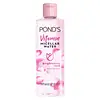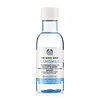Pond's Vitamin Micellar Water Brightening Rose Versus The Body Shop Camomile Waterproof Eye & Lip Make-Up Remover
What's inside
What's inside
 Key Ingredients
Key Ingredients

No key ingredients
 Benefits
Benefits

 Concerns
Concerns

 Ingredients Side-by-side
Ingredients Side-by-side

Water
Skin ConditioningHexylene Glycol
EmulsifyingGlycerin
HumectantNiacinamide
SmoothingRosa Gallica Flower Extract
AstringentRosa Damascena Flower Oil
MaskingSodium Ascorbyl Phosphate
AntioxidantPanthenol
Skin ConditioningRetinyl Propionate
Skin ConditioningPaeonia Lactiflora Root Extract
Skin ConditioningTocopheryl Acetate
AntioxidantHydroxyethyl Urea
HumectantUrea
BufferingPEG-6 Caprylic/Capric Glycerides
EmulsifyingPropylene Glycol
HumectantSodium Chloride
MaskingPotassium Chloride
Parfum
MaskingTrideceth-9
EmulsifyingPEG-40 Hydrogenated Castor Oil
EmulsifyingAmmonium Lactate
BufferingCetrimonium Chloride
AntimicrobialCetylpyridinium Chloride
AntimicrobialCitric Acid
BufferingEthanolamine
BufferingBenzophenone-4
UV AbsorberTetrasodium EDTA
Phenoxyethanol
PreservativeCI 14700
Cosmetic ColorantCI 17200
Cosmetic ColorantWater, Hexylene Glycol, Glycerin, Niacinamide, Rosa Gallica Flower Extract, Rosa Damascena Flower Oil, Sodium Ascorbyl Phosphate, Panthenol, Retinyl Propionate, Paeonia Lactiflora Root Extract, Tocopheryl Acetate, Hydroxyethyl Urea, Urea, PEG-6 Caprylic/Capric Glycerides, Propylene Glycol, Sodium Chloride, Potassium Chloride, Parfum, Trideceth-9, PEG-40 Hydrogenated Castor Oil, Ammonium Lactate, Cetrimonium Chloride, Cetylpyridinium Chloride, Citric Acid, Ethanolamine, Benzophenone-4, Tetrasodium EDTA, Phenoxyethanol, CI 14700, CI 17200
Water
Skin ConditioningIsododecane
EmollientIsopropyl Palmitate
EmollientPotassium Phosphate
BufferingHexylene Glycol
EmulsifyingSodium Chloride
MaskingAnthemis Nobilis Flower Water
MaskingDipotassium Phosphate
BufferingTrisodium Ethylenediamine Disuccinate
Decyl Glucoside
CleansingPolyaminopropyl Biguanide
PreservativeDisodium EDTA
Arginine
MaskingTaurine
BufferingCitric Acid
BufferingPotassium Sorbate
PreservativeSodium Benzoate
MaskingWater, Isododecane, Isopropyl Palmitate, Potassium Phosphate, Hexylene Glycol, Sodium Chloride, Anthemis Nobilis Flower Water, Dipotassium Phosphate, Trisodium Ethylenediamine Disuccinate, Decyl Glucoside, Polyaminopropyl Biguanide, Disodium EDTA, Arginine, Taurine, Citric Acid, Potassium Sorbate, Sodium Benzoate
 Reviews
Reviews

Ingredients Explained
These ingredients are found in both products.
Ingredients higher up in an ingredient list are typically present in a larger amount.
Citric Acid is an alpha hydroxy acid (AHA) naturally found in citrus fruits like oranges, lemons, and limes.
Like other AHAs, citric acid can exfoliate skin by breaking down the bonds that hold dead skin cells together. This helps reveal smoother and brighter skin underneath.
However, this exfoliating effect only happens at high concentrations (20%) which can be hard to find in cosmetic products.
Due to this, citric acid is usually included in small amounts as a pH adjuster. This helps keep products slightly more acidic and compatible with skin's natural pH.
In skincare formulas, citric acid can:
While it can provide some skin benefits, research shows lactic acid and glycolic acid are generally more effective and less irritating exfoliants.
Most citric acid used in skincare today is made by fermenting sugars (usually from molasses). This synthetic version is identical to the natural citrus form but easier to stabilize and use in formulations.
Read more about some other popular AHA's here:
Learn more about Citric AcidHexylene Glycol is a surfactant. Glycols are a class of alcohols. Hexylene Glycol is a surfactant and emulsifier.
As a surfactant, Hexylene Glycol helps gather dirt and oil on your skin to be washed away.
As an emulsifier, Hexylene Glycol helps keep water and oil together. This prevents them from separating in a product. Hexylene Glycol also thins out the texture of a product by lessening viscosity.
Hexylene Glycol has a small molecular weight.
Learn more about Hexylene GlycolChances are, you eat sodium chloride every day. Sodium Chloride is also known as table salt.
This ingredient has many purposes in skincare: thickener, emulsifier, and exfoliator.
You'll most likely find this ingredient in cleansers where it is used to create a gel-like texture. As an emulsifier, it also prevents ingredients from separating.
There is much debate on whether this ingredient is comedogenic. The short answer - comedogenic ratings don't tell the whole story. Learn more about comegodenic ratings here.
The concensus about this ingredient causing acne seems to be divided. Research is needed to understand if this ingredient does cause acne.
Scrubs may use salt as the primary exfoliating ingredient.
Learn more about Sodium ChlorideWater. It's the most common cosmetic ingredient of all. You'll usually see it at the top of ingredient lists, meaning that it makes up the largest part of the product.
So why is it so popular? Water most often acts as a solvent - this means that it helps dissolve other ingredients into the formulation.
You'll also recognize water as that liquid we all need to stay alive. If you see this, drink a glass of water. Stay hydrated!
Learn more about Water